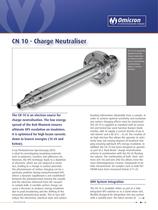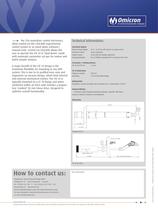
Catalog excerpts

MBE PRO 753-V01/Oct10 CN 10 - Charge Neutraliser The CN 10 is specifically designed to provide charge compensation for analysis of insulating or semiconducting materials during photon or ion bombardment. The CN 10 is an electron source for charge neutralisation. The low energy spread of the BaO filament ensures ultimate XPS resolution on insulators. It is optimised for high beam currents down to lowest energies (10 eV and below). X-ray Photoelectron Spectroscopy (XPS) is ideal for investigating insulating materials such as polymers, ceramics and adhesives etc. However, the XPS technique leads to a depletion of electrons, which are not replaced in insulators, leading to a change in surface potential. The phenomenon of surface charging can be a particular problem during monochromated XPS, where a dynamic equilibrium is not established between the photoelectrons leaving the sample and the electrons delivered from the vacuum or sample bulk. A variable surface charge can cause a decrease in analyser energy resolution due to peak broadening and the shifting of the measured photoelectron peaks. This in turn will reduce the elemental, chemical state and surface www.omicron.de bonding information obtainable from a sample. In order to achieve optimal sensitivity and resolution any surface charging effects must be minimised. The CN 10 is supplied as standard with an activated and tested low work function Barium Oxide emitter, able to supply a current density of up to 400 nAmm2 and a KE of 0 ...16 eV. The creation of an high electron flux allows the operator to selectively tune out varying degrees of localised charging ensuring optimum XPS energy resolution. In addition the CN 10 has been designed to operate as part of a ‘Dual-Beam’ charge neutralisation scheme in combination with the FIG 05 floating ion column. The combination of both ‘slow’ electrons (CN 10) and ions (FIG 05) allows even the most inhomogeneous ceramic compounds to be fully characterised. On samples such as bulk PET FWHM have been measured below 0.71 eV. UHV System integration The CN 10 is available either as part of a fully integrated XPS solution or as a stand-alone unit, flexibly designed for integration into any system with a suitable port. The latest version of
Open the catalog to page 1
the 556 neutraliser control electronics, allow control via the CASCADE experimental control system or as stand-alone software/ manual units. Control via CASCADE allows the user to operate the CN 10 in ‘Dual-Beam’ mode with automatic parameter set-ups for routine and batch sample analysis. Technical Information: Functional outputs Kinetic Energy Range: 0 eV – 16.38 eV with respect to vacuum level Emission Current: 50 µA maximum Target Current: 10 µA with all settings optimised Energy Resolution: 0.8 eV FWHM examining PET C1s peak at 289 eV B.E Focal point / working distance A major benefit...
Open the catalog to page 2All Scienta Omicron catalogs and technical brochures
-
NanoESCA
4 Pages
-
UHV Suitcase
2 Pages
-
ARPES-Lab
4 Pages
-
Cryo Manipulators
2 Pages
-
XPS-Lab
2 Pages
-
Fermi DryCool SPM
8 Pages
-
TESLA JT SPM
8 Pages
-
EFM Evaporators
8 Pages
-
Argus CU
7 Pages
-
UHV NANOPROBE
12 Pages
-
Fermi SPM
8 Pages
-
Leonova Diamond
8 Pages
-
Leonova Emerald
12 Pages
-
Intellinova
4 Pages
-
MULTIPROBE
8 Pages
-
Omicron EFM V05
8 Pages
-
PRO-75/100 MBE Systems
2 Pages
-
EVO-25/50 MBE Systems
2 Pages
-
LAB-10 MBE System
2 Pages
-
ISE 5
2 Pages
-
EKF 300
2 Pages
-
MBD-LEED
8 Pages
-
FOCUS PEEM
16 Pages
-
Argus
12 Pages
-
MULTISCAN Lab
2 Pages
-
LT NANOPROBE
8 Pages
-
UHV STM 1
2 Pages
-
Cryogenic STM & SFM
4 Pages
-
SPHERA
8 Pages
-
NanoSAM Lab
6 Pages
Archived catalogs
-
VT SPM
11 Pages
-
LT STM_2017
16 Pages
-
ESCA+_2010
8 Pages
-
VT SPM_2012
20 Pages
-
LT STM_2012
16 Pages
-
SPM PROBE
2 Pages
-
MATRIX SPM Control System
8 Pages
-
MS5 & Control Unit
2 Pages
-
EFM 2
8 Pages
-
EKF 1000
2 Pages
-
SPECTALEED
8 Pages
-
CMA 100
4 Pages
-
NanoESCA
8 Pages
-
Multiscan STM
2 Pages
















































